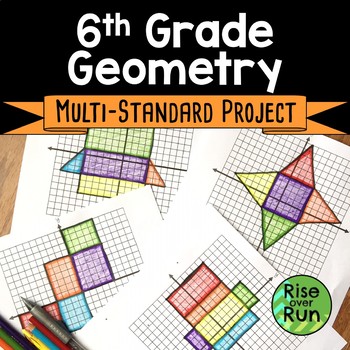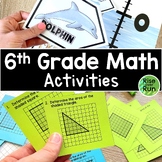6th Grade Math Geometry Project for End of the Year with Nets and Surface Area
- Zip
What educators are saying
Also included in
- Looking for sixth grade math resources that are engaging, meaningful, standards-based, and help build conceptual understanding? In this big pack are 35+ resources that include hands-on learning, card sorts, games, projects, group activities, and more! These activities are rigorous and engaging. AsPrice $73.00Original Price $109.25Save $36.25
Description
With this project, students must identify nets and 3D figures along with calculating surface area, perimeters, and volume. It is great way to practice several sixth grade standards!
Students get hands-on experience working with nets, surface area, and volume. Not only is this activity engaging, but it will help create a conceptual understanding of 3D figures and their attributes.
The project has 4 parts and 2 Follow Up practice worksheets. The parts can be assigned to individual students or partners.
- Part A: Students graph points to create a net of a rectangular prism. They cut out and create the 3D figure, find volume and surface area, and answer questions. This is a good one to do as a whole class so students get the idea.
- Part B: Next students create a rectangular prism whose net is configured differently. They create the 3D figure by cutting it out and folding it, and then answer questions.
- Part C: Then students graph points to create the net of a pyramid. They cut it out and work with the 3D figure to answer questions.
- Part D: Finally students create the net of a triangular prism. They work with the 3D figure to answer questions.
A large graph is included if you would like to print it for each part. Or, students can draw their own graphs on graph paper. Students will need a graph, colored pencils/markers, scissors, and tape for each part.
Follow Up: Two practice sheets are provided after the project. These extend students’ thinking about surface area and volume. They could be assigned as homework or classwork.
A scoring checklist is provided to help you with grading. This can be used as a rubric. The scoring checklist is provided as an editable pptx document.
Answer Keys are included.
The project and answer key are provided as a PDF.
Check out the preview for a closer look.
___________________________________________
Here's what teachers like you said about this Net & Surface Area activity:
⭐️⭐️⭐️⭐️⭐️Miss Fela says, "My kids absolutely loved this project! It was such a great way to cover multiple standards at a time, as well as to help them visualize their math. Will totally use this again next year!"
⭐️⭐️⭐️⭐️⭐️ Callie N. says, "I used this at the end of the year 2021 right before state testing and my student's performed so well on the geometry piece of their standardized assessment. Very interactive and good for students of all abilities (with support)."
⭐️⭐️⭐️⭐️⭐️ Debbie Hurtado says, "WOW! Worth every penny. We used this at the end of our unit as a summative project. These activities generated some great conversations and questions. Highly engaging."
⭐️⭐️⭐️⭐️⭐️ Joseph A. says, "This resource is a must have! Hands on activity, while students visually learn about surface area. I used this for an observation lesson and was a home run! Thank you. "
⭐️⭐️⭐️⭐️⭐️ Staci J. says, "My students loved this activity. We did part A together and they completed the rest on their own. They have been struggling with nets and surface area, and this really put it all together for them. Thanks for such an engaging resource!"
___________________________________________
Common Core Standards:
6.G.A.1 Find the area of right triangles, other triangles, special quadrilaterals, and polygons by composing into rectangles or decomposing into triangles and other shapes; apply these techniques in the context of solving real-world and mathematical problems.
6.G.A.3 Draw polygons in the coordinate plane given coordinates for the vertices; use coordinates to find the length of a side joining points with the same first coordinate or the same second coordinate. Apply these techniques in the context of solving real-world and mathematical problems.
6.G.A.4 Represent three-dimensional figures using nets made up of rectangles and triangles, and use the nets to find the surface area of these figures. Apply these techniques in the context of solving real-world and mathematical problems.
6.NS.C.8 Solve real-world and mathematical problems by graphing points in all four quadrants of the coordinate plane. Include use of coordinates and absolute value to find distances between points with the same first coordinate or the same second coordinate.
Looking for a 7th grade version of this project? Check here!






